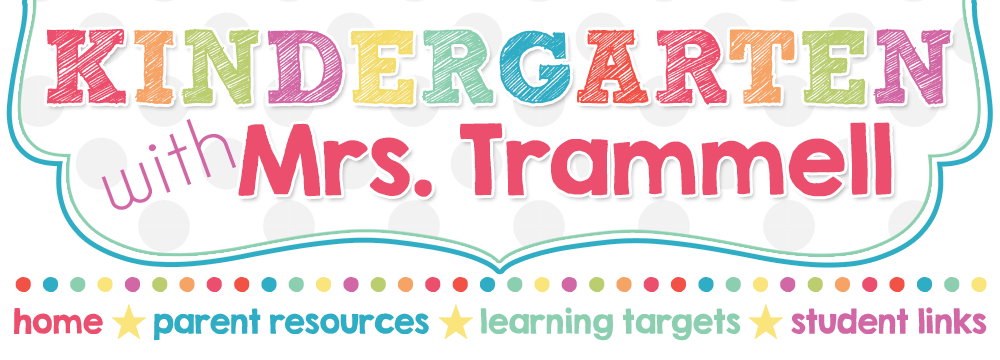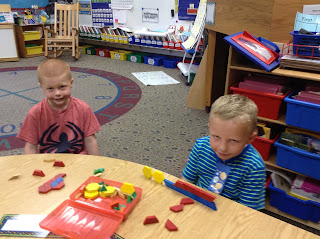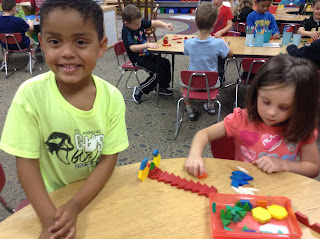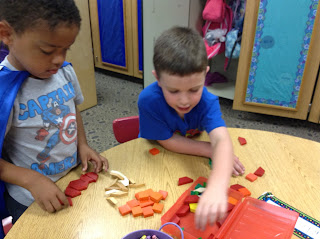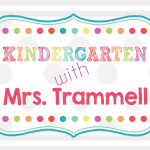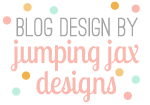One of our focuses in reading lately has been predicting what might happen in the text. When readers make predictions, they are focused on what is happening in the text. Readers are able to take what is happening in the book, add it to their background knowledge and make a prediction as to what happens next.
We've been talking about predictions that make sense, and boy have I been impressed! The class seems to get that making a prediction that actually might happen is key. We've been working on knowing that it's okay for predictions to be wrong--we just have to make sure we find out whether our predictions came true in the text.
Readers can make predictions using any book, and we make predictions on every book we've read. When reading all of the gingerbread man books, we were able to predict what might happen based on knowing the other stories we've read. These books were a few of our favorites in helping us learn to make predictions while we read:
Blueberries for Sal by Robert McCloskey is a great book to work on predictions while reading the text. If you are familiar with the story, you'll know that the actions of Sal and the Little Bear mirror each other, which makes it easier to make connections and predict what will happen next.
Wolf's Coming by Joe Kulka is another book where students can easily make predictions based on what they already know. It has a surprising ending which makes checking our predictions fun because then we can go back and look at the clues we might have missed.
Suddenly! by Colin McNaughton is just a fun book. We were able to make many correct predictions, especially when we noticed the author's style and pattern.
We will continue talking about making predictions all year. When reading at home, see what predictions your child can make and don't forget to see if he or she was correct. Happy reading!
Wednesday, December 16, 2015
Sunday, December 6, 2015
Comparing and Contrasting Two Stories
We're working retelling stories that we've read during our read aloud or shared reading time. After we've retold the story, we're able to compare the story to another story we've read. I've been impressed with how well this is going as a whole group! Yea!
One of the stories we read was Sofia and the Sunflower.
One of the stories we read was Sofia and the Sunflower.
It's about a girl who plants some magic seeds which turn out to be giant sunflowers. She decides to climb up the sunflower and finds a castle in the clouds. What does this story remind you of? That's right! Jack and the Beanstalk. We read that story next, and we were able to come up with many story elements that were the same or similar in the two texts. We made a thinking map to show our thinking:
Recently we read two gingerbread men stories: The Gingerbread Man retold by Jim Aylesworth and The Gingerbread Cowboy by Janet Squires. Here's our thinking map for those two tales:
Comparing books helps us develop as readers in many ways. First, we get to practice retelling a story with the characters, the setting, and the main events in order. Also, we get to practice making connections between stories. Making connections helps us remember what happened in the text and consider the text in new ways. Lastly, we as readers get to respond to the texts and discuss them with each other. It's always great when readers can see the book through another's point-of-view.
We'll be connecting between texts often in our class. When reading at home, ask your child if he or she can think of a book that is similar to the one you are currently reading. Discuss the similarities at home! Happy reading!
Monday, November 23, 2015
Handwriting and Phonics in Our Classroom
Soon you will see papers like this coming home:
We're using it for both handwriting and phonics.
Handwriting
We're learning how to write all of the letters, both upper and lower case. When we write a letter, our target is to write the letter correctly. We'll know that we've hit the target when the letter is the right size and the right shape. The right size is the tricky one for most kindergarten students. The two lines you see might be different than what you are used to seeing. The top line is actually the mid-line, and the bottom line is the bottom line. Some letters, like all of the capitals, go above the mid-line (that top line). We talk about "bumping"the lines so that our letters will be the right size.
We're transitioning to primarily using lower case letters in our writing. When you see these papers, you might see a lot of letters I've written with a marker. It might look a little overwhelming sometime with all of the marker marks, but I'm just trying to demonstrate how a letter should look on this page. I know we're in the practice phase of handwriting, and I want students to visually see what the letter should look like in both size and shape. Kindergarten is a time to establish good handwriting habits. It may seem like I'm being picky, but I'm trying to set good examples.
Phonics
This paper is also a way for us to practice our letter sounds and spelling words. On the top row with the triangle, I say a sound and the students write the letter that makes the sound. On the second row with the square, we practice saying and spelling words. I will say a word and the students will repeat it. Then students stretch out the word to listen to the sounds they hear. Then they write the word writing the letters that correspond with the sounds they hear. The last two rows (the heart) is where we practice handwriting and sight words.
Most of the days we do this paper, we complete it together. I have an identical paper that the students help me fill out. This way, students can check their work against the class copy. They are encouraged to make corrections as needed, and everyone knows each answer before we move on to the next sound or word. So when the paper comes home, you might just notice marker marks made by me to help correct handwriting.
Sometimes you'll notice a score at the top. About once a week we will do the same routine but students will not be able to check their work against the class copy. It will be taken as an assessment to help me know how well the students are picking up on the letter-sound correspondence and how well students are figuring out how to spell simple words. Doing this helps me know when it's time to move on to a new letter or concept and when it's time to reteach certain letters and sounds. This time is similar to a quiz. I want to know what the students can do independently. The score on the top will show how many sounds / letters and words your child got correct. Since we don't have grades in kindergarten, I won't be recording the scores as an A or a B. I put the score on there so you would know two things: 1. The paper was done independently. 2. How your child performed. Remember, since I'm looking at handwriting, too, it might look like your child missed a letter or a word when really he or she didn't. If there is no score on the paper, we did it together in class and your child could see all of the answers as we went along. I'm really happy with our progress so far!
Last week I sent home alphabet cards in a baggie for your child to keep. Feel free to use these with your child to help learn letters and sounds.
We're using it for both handwriting and phonics.
Handwriting
We're learning how to write all of the letters, both upper and lower case. When we write a letter, our target is to write the letter correctly. We'll know that we've hit the target when the letter is the right size and the right shape. The right size is the tricky one for most kindergarten students. The two lines you see might be different than what you are used to seeing. The top line is actually the mid-line, and the bottom line is the bottom line. Some letters, like all of the capitals, go above the mid-line (that top line). We talk about "bumping"the lines so that our letters will be the right size.
We're transitioning to primarily using lower case letters in our writing. When you see these papers, you might see a lot of letters I've written with a marker. It might look a little overwhelming sometime with all of the marker marks, but I'm just trying to demonstrate how a letter should look on this page. I know we're in the practice phase of handwriting, and I want students to visually see what the letter should look like in both size and shape. Kindergarten is a time to establish good handwriting habits. It may seem like I'm being picky, but I'm trying to set good examples.
Phonics
This paper is also a way for us to practice our letter sounds and spelling words. On the top row with the triangle, I say a sound and the students write the letter that makes the sound. On the second row with the square, we practice saying and spelling words. I will say a word and the students will repeat it. Then students stretch out the word to listen to the sounds they hear. Then they write the word writing the letters that correspond with the sounds they hear. The last two rows (the heart) is where we practice handwriting and sight words.
Most of the days we do this paper, we complete it together. I have an identical paper that the students help me fill out. This way, students can check their work against the class copy. They are encouraged to make corrections as needed, and everyone knows each answer before we move on to the next sound or word. So when the paper comes home, you might just notice marker marks made by me to help correct handwriting.
Sometimes you'll notice a score at the top. About once a week we will do the same routine but students will not be able to check their work against the class copy. It will be taken as an assessment to help me know how well the students are picking up on the letter-sound correspondence and how well students are figuring out how to spell simple words. Doing this helps me know when it's time to move on to a new letter or concept and when it's time to reteach certain letters and sounds. This time is similar to a quiz. I want to know what the students can do independently. The score on the top will show how many sounds / letters and words your child got correct. Since we don't have grades in kindergarten, I won't be recording the scores as an A or a B. I put the score on there so you would know two things: 1. The paper was done independently. 2. How your child performed. Remember, since I'm looking at handwriting, too, it might look like your child missed a letter or a word when really he or she didn't. If there is no score on the paper, we did it together in class and your child could see all of the answers as we went along. I'm really happy with our progress so far!
Last week I sent home alphabet cards in a baggie for your child to keep. Feel free to use these with your child to help learn letters and sounds.
Saturday, November 14, 2015
Apps for Math
There are lots of fun apps for learning or practicing math. Let's dive right in with some of my favorites in no particular order!
Base Ten Bingo is a great way to practice visualizing numbers and be ready for first grade math. I love how it's differentiated, too. This app is part of ABCya.com's family of apps, so if you and your child like this one, maybe you'll find others you like as well.
(currently free)
Everyday Math is our math curriculum for Carmel Elementary, so any EDM apps would be great. Beat the Computer is one of my favorites because who doesn't want to be smarter than a computer?
Truth be told I don't remember if I have the paid version or the free version, but this is one of my favorite math apps for kindergarten. Why? It's because of the variety of math skills offered. Typically apps for kindergarten math focus on number sense or computation, but Math Seeds has activities for practice in measurement, money, data, fractions, grouping, sharing, and more!
(currently free)
This app seems engaging to many kindergartners. Check out the daily challenges.
Top-It (for Everday Math)
(currently free)
(currently free)
Another Everyday Math app . . . easy way to practice addition.
As always, I recommend that you check out the app first before you give it to your child. A website I like using as a mom to check and see if media is appropriate for my own sons is commonsensemedia.org.
Thursday, October 22, 2015
Learning About Nouns
We're learning about nouns! We've learned that nouns are people, places, and things. Here is a thinking map of the three types of nouns.
Look at some examples of people:
Here are examples of places:
We could think of many things:
Try going on a noun hunt in your home, your neighborhood, the store, or anywhere! What nouns can you find?
Look at some examples of people:
Here are examples of places:
We could think of many things:
Try going on a noun hunt in your home, your neighborhood, the store, or anywhere! What nouns can you find?
Thursday, October 15, 2015
Making Connections
We've been reading several books about families lately. What an easy way to learn about something all good readers do: make connections! When readers make connections, they notice something in the book that reminds them of something they already know.
When we made connections as a class, we first noticed something important in the book. In one of the books we read, each time something happened in the text that reminded us of our families, we put a thumbs up. With another book, we were able to draw a picture of what happened in the text and then we drew another picture of our connection. Take a look:
Try making connections while reading at home!
When we made connections as a class, we first noticed something important in the book. In one of the books we read, each time something happened in the text that reminded us of our families, we put a thumbs up. With another book, we were able to draw a picture of what happened in the text and then we drew another picture of our connection. Take a look:
Try making connections while reading at home!
Tuesday, October 13, 2015
Rhyme Time
One of our goals is to recognize and produce rhymes. Here are some ideas on how to help your child with rhyming at home.
*One of the best things to do is to read nursery rhymes, like Mother Goose. It's a great way for readers to pick up on rhymes, syllables, phonemic awareness, and rhythm.
*When reading a rhyming book, try omitting the second rhyme and see if you child can figure out what word should be read.
*Sing silly rhyming songs. Two of our favorites are by Raffi and the Wiggles. Here is Down by the Bay and here is Willaby Wallaby Woo by the Wiggles (although Raffi does one as well). See if your child can think of new verses!
*Play a game! Say, I spy with my little eye something that starts with /m/ and rhymes with house. What is it? A mouse!
*Say a word. You and your child can think of as many words as you can that rhyme with the first word. Nonsense words count!
Have fun rhyming!
*One of the best things to do is to read nursery rhymes, like Mother Goose. It's a great way for readers to pick up on rhymes, syllables, phonemic awareness, and rhythm.
*When reading a rhyming book, try omitting the second rhyme and see if you child can figure out what word should be read.
*Sing silly rhyming songs. Two of our favorites are by Raffi and the Wiggles. Here is Down by the Bay and here is Willaby Wallaby Woo by the Wiggles (although Raffi does one as well). See if your child can think of new verses!
*Play a game! Say, I spy with my little eye something that starts with /m/ and rhymes with house. What is it? A mouse!
*Say a word. You and your child can think of as many words as you can that rhyme with the first word. Nonsense words count!
Have fun rhyming!
Sunday, October 11, 2015
Learning About the Main Idea
We're learning how to tell about the main idea of a book. There are a few clues we can use to help us. One clue is to look to the title. What does the title tell us . . . what the book is about! Another thing we can do is ask ourselves: what is this book mostly about?
We've read many books so far to talk about the main idea. One of the books we read to help us understand the main idea is Kevin Henkes' Wemberly Worried. What was this book mostly about? Wemberly worried about everything!
Not only did we determine the main idea, but we noticed the clues, or details, to help us figure it out. Take a look at the chart we made to help us show our thinking:
Another book we read is titled Gio and His Family. What was this book mostly about? Gio and his family and what they like to do together! How did we know that? Both the title and the events of the book told us! You may have seen a similar chart come home with your child that looks similar to the Wemberly chart (I forgot to take a picture of us completing it in action!).
When reading at home, see if your child can help determine the main idea of the book!
We've read many books so far to talk about the main idea. One of the books we read to help us understand the main idea is Kevin Henkes' Wemberly Worried. What was this book mostly about? Wemberly worried about everything!
Not only did we determine the main idea, but we noticed the clues, or details, to help us figure it out. Take a look at the chart we made to help us show our thinking:
Another book we read is titled Gio and His Family. What was this book mostly about? Gio and his family and what they like to do together! How did we know that? Both the title and the events of the book told us! You may have seen a similar chart come home with your child that looks similar to the Wemberly chart (I forgot to take a picture of us completing it in action!).
When reading at home, see if your child can help determine the main idea of the book!
Saturday, October 10, 2015
Sight Word Apps
We are learning more sight words by the day! Here are some apps that you might find helpful for your child. As with the handwriting apps, I do not have the storage to house all of these apps on my device, so I haven't personally checked each of these apps. I recommend that you check out the app first before you give it to your child. A website I like using as a mom to check and see if media is appropriate for my own sons is commonsensemedia.org. Happy sight word practicing!
Here are some apps for sight words in no particular order:
Here are some apps for sight words in no particular order:
Sight Word Ninja
(currently free)
(currently free)
(currently free)
Sight Word Learning Games
(currently free)
(currently free)
(currently free)
Sight Words that Teach Speech
(currently $0.99)
(currently $0.99)
Friday, October 9, 2015
Learning About Illustrations
Previously we've learned that there are three ways to read a book, and one of those ways is to read the pictures. Lately we have been learning about illustrations in a text and how they help us read a story. There are lots of things we can do to read the pictures!
First, good readers take a picture walk before reading the book. What is a picture walk? It's when readers take a quick look at the pictures in the text and think about these three questions: What is the book about? What do I think/predict is going to happen? What do I already know about this text? Picture walks help readers understand the book.
Another thing we've been doing with the illustrations in a book is learning to ask five questions: Who is in the picture? What are they doing? Where are they? When is it? Why do you think . . . ? Doing this helps readers know what is happening in the text. Readers can make connections or predictions based off the pictures in the text. It helps understand the sequence of the story as well.
In some books we've noticed that sometimes the illustrations tell the story more so that the words. We read Mem Fox's Tough Boris and enjoyed not only learning about Tough Boris but also realizing the story that takes place in the pictures as well.
Finally, we've learned that there is a relationship between the pictures in the story and the words on the page. They have to match! This will help us, too, when writing our own stories.
When reading at home, see what information your child can get from looking at the illustrations!
First, good readers take a picture walk before reading the book. What is a picture walk? It's when readers take a quick look at the pictures in the text and think about these three questions: What is the book about? What do I think/predict is going to happen? What do I already know about this text? Picture walks help readers understand the book.
Another thing we've been doing with the illustrations in a book is learning to ask five questions: Who is in the picture? What are they doing? Where are they? When is it? Why do you think . . . ? Doing this helps readers know what is happening in the text. Readers can make connections or predictions based off the pictures in the text. It helps understand the sequence of the story as well.
In some books we've noticed that sometimes the illustrations tell the story more so that the words. We read Mem Fox's Tough Boris and enjoyed not only learning about Tough Boris but also realizing the story that takes place in the pictures as well.
Finally, we've learned that there is a relationship between the pictures in the story and the words on the page. They have to match! This will help us, too, when writing our own stories.
When reading at home, see what information your child can get from looking at the illustrations!
Thursday, October 8, 2015
Monday, October 5, 2015
Counting, Counting, Counting
We're working hard on learning how to count. We're learning how to count to 100 (any beyond!) and learning how to count objects.
One of the things we do each day is use the 100s chart to count. This helps us learn what the numbers look like, which number comes next, and helps us work from left to right. Another thing we love to do is to sing and dance with Jack Hartmann's video: Count to 100. I love this video because the students can use so many senses while learning to count to 100. They can hear, see, and say the numbers. I've been know to put this video on for my own kids while traveling because it's good at getting the kinks out!
Last week our home link focused on counting up to your front door. We've ready many books about counting, but one that stands out is Christopher Counting by Valeri Gorbachev. Christopher counted everything! He counted everything in his backpack, he counted butterflies in the air, and he counted the peas on his plate. That got us thinking: what could we count? Can we count the number of pages in a book? Can we count how many socks are in the sock drawer? Can we count how many times we can dribble a ball? Can we count how long it will take us to make our beds? Yes!
We're not just counting by 1s. We're learning how to count by 10s as well. Counting by 10s will help us learn how to count by 1s. For example, what number does come after 49? When we make associations with counting by 10s, it will help us know the next number. We're counting backwards, too. Who doesn't love the finger play of Five Little Monkeys?
Also, we've learned how to use our fingers to count. This can get tricky with little hands. We've practiced counting with our index finger first and then moving across to the rest of the fingers and saving the thumb for last. When the thumb comes out too soon it can mess up too many of our counts. See us learning how to use our fingers the kindergarten way:
Finally, we're learning how to count objects. Our goal is make an accurate count, and we'll be able to do that by moving each object over to a new area so that we won't count it again. We're working on saying the next number only when we've moved an object--not counting too fast or too slow. Candy season is just around the corner. Next time your child gets a bag of Skittles or M&Ms, have them count each candy in the bag, and then count it again to make sure he/she got the count correct. Don't forget to move each piece!
Have fun counting!
Last week our home link focused on counting up to your front door. We've ready many books about counting, but one that stands out is Christopher Counting by Valeri Gorbachev. Christopher counted everything! He counted everything in his backpack, he counted butterflies in the air, and he counted the peas on his plate. That got us thinking: what could we count? Can we count the number of pages in a book? Can we count how many socks are in the sock drawer? Can we count how many times we can dribble a ball? Can we count how long it will take us to make our beds? Yes!
We're not just counting by 1s. We're learning how to count by 10s as well. Counting by 10s will help us learn how to count by 1s. For example, what number does come after 49? When we make associations with counting by 10s, it will help us know the next number. We're counting backwards, too. Who doesn't love the finger play of Five Little Monkeys?
Also, we've learned how to use our fingers to count. This can get tricky with little hands. We've practiced counting with our index finger first and then moving across to the rest of the fingers and saving the thumb for last. When the thumb comes out too soon it can mess up too many of our counts. See us learning how to use our fingers the kindergarten way:
Finally, we're learning how to count objects. Our goal is make an accurate count, and we'll be able to do that by moving each object over to a new area so that we won't count it again. We're working on saying the next number only when we've moved an object--not counting too fast or too slow. Candy season is just around the corner. Next time your child gets a bag of Skittles or M&Ms, have them count each candy in the bag, and then count it again to make sure he/she got the count correct. Don't forget to move each piece!
Have fun counting!
Thursday, September 24, 2015
Friday, September 18, 2015
Kindergarten Friendly Apps for Handwriting
Here are some kindergarten friendly apps for handwriting that might be worth trying out at home. These are listed in no particular order, and they may have a cost. These are optional, and feel free to choose an app most appropriate for your child. I have not tried all of these apps (I only have so much storage--ha!). As a parent, one of my go-to websites to learn about apps and other media before deciding whether to share it with my boys is commonsensemedia.org. Feel free to use that site to check out any media before exposing it to your child.
Click on the picture to find more information from iTunes.
Little Writer
(currently free)
Handwriting Without Tears
(currently $4.99)
(currently $4.99)
iWrite Words
(currently $2.99)
(currently $2.99)
Letter School
(currently $4.99)
(currently $4.99)
Writing Wizard
(currently $4.99)
(currently $4.99)
There are more handwriting apps out there. Feel free to do your own search if you are looking for other options.
Thursday, September 17, 2015
Handwriting
We're learning how to write letters correctly. We want letters to be the right shape and the right size. Before we started learning how to write specific letters, we noticed that letters had common strokes like vertical or diagonal lines. We took some time to sort letters by their lines.
Here we are looking for letters.
Can you find a letter with diagonal lines?
Can you find a letter with a curve?
Can you find a letter with a vertical line?
When out and about, go on a letter hunt. What letter(s) do you see with a horizontal line, etc.? Also, ask your child where letters start!
Here we are looking for letters.
Can you find a letter with diagonal lines?
Can you find a letter with a curve?
Can you find a letter with a vertical line?
When out and about, go on a letter hunt. What letter(s) do you see with a horizontal line, etc.? Also, ask your child where letters start!
Wednesday, September 16, 2015
What Can You Do with Pattern Blocks?
What can you do with pattern blocks? You can explore, build, design, sort, and make patterns! Which activity can you see happening the pictures?
Working with pattern blocks is fun!
Working with pattern blocks is fun!
Subscribe to:
Posts (Atom)
